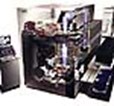PAS 5500/900 193 nm Step and Scan System

The wide-field PAS 5500/900 193 nm step and scan system is on target for developing next-generation processes for linewidths from 150 nm down to 130 nm. The system meets the SIA (Semiconductor Industry Association) Technology Roadmap's timeline for qualification and pre-production of advanced 1-4-gigabit DRAMs and gigahertz-speed logic devices.
The tool is built upon PAS 5500 system architecture and uses the company's high-speed step and scan stages. A key difference from the 248 nm PAS 5500/500 is the use of Carl Zeiss' Starlith 900 lens with calcium fluoride (CaF2) elements for partial achromatization.
Also critical in achieving 150 nm resolution is an argon fluoride (ArF) laser source and the AERIAL II illuminator with high-transmission CaF2 and aspherical optical elements from Carl Zeiss. The PAS 5500/900 incorporates major technology breakthroughs in several critical areas. To produce the optics, Carl Zeiss' knowledge in CaF2 lens production was extended to meet volume manufacturing demands for 193 nm projection lenses.
Coating technologies and polishing methods had to be developed to handle the crystalline structure of CaF2. Fully automated polishing systems produce the required surface accuracies of the quartz and CaF2 elements.
With its very large working distance from the final lens element to the photoresist's surface, the refractive optics design avoids lens contamination caused by outgassing from 193 nm photoresists during exposure. Compared to catadioptric lens design, where the lens is situated much closer to the photoresist, refractive lenses ensure increased uptime and productivity.
Developing the PAS 5500/900 optics also required advances in the manufacturing capabilities of the principal materials suppliers. Critical CaF2 homogeneity and purity specifications and required low levels of strain birefringence are manufacturing challenges being met by Schott and Bicron.
For 193 nm-compatible quartz, Carl Zeiss enlisted Heraeus and Corning. Utilizing the resulting Starlith 900 lens with a numerical aperture (NA) adjustable from 0.45 to <0.6, the PAS 5500/900 produces a field size of 26 x 33 mm. Creating reliable ArF laser sources with lens bandwidths of 0.7 picometer and power specifications of 5 watts at 1,000 Hz was another vital need and was developed in parallel by Cymer and Lambda Physik, both of whom supply ArF lasers for the PAS 5500/900 system.
ASML the Netherlands, De Run 1110, 5503 LA Veldhoven, The Netherlands. Tel: 40.2303000; Fax: 40.2303565.
